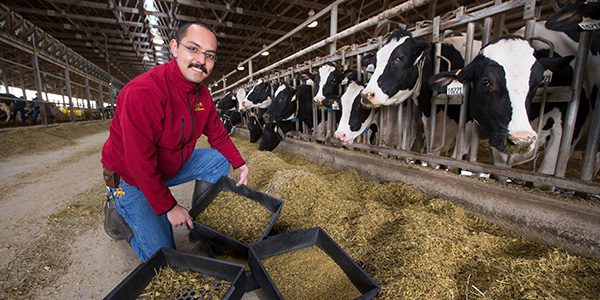
Preparing Real-World Professionals with Real-World Data
Hugo Ramirez-Ramirez is a land-grant triple threat. His appointment at Iowa State is threefold, combining extension, research and teaching. His class, Applied Dairy Farm Evaluation, provides students with a capstone experience to their undergraduate career.
“Each student in the class works with a real farm,” Ramirez-Ramirez says. “They have access to the farm’s data and analyze those records throughout the course of the semester.”
It provides an opportunity for students to move away from the theoretical and put what has been taught in a classroom to use.
“I really try to bring as much knowledge and information about current issues I’ve gathered from my extension work into the classroom,” Ramirez-Ramirez says. “That allows students to know what people are experiencing and get a taste of what is going on in the industry.”
It was his own experience on a dairy farm in central Mexico that shaped the way he approaches education.
Ramirez-Ramirez, an assistant professor and extension dairy specialist with Iowa State University, spent the year after earning his undergraduate degree as the dairy herd manager at a farm in Leon, Guanajuato, Mexico, where he was responsible for the care of 1,000 animals.
“That experience helped me realize the type of things students will need to have in their toolbox when they graduate,” Ramirez-Ramirez says. “It helped me develop a teaching style that combines things that may seem abstract and show why that information is important when managing a farm.”
His research and extension appointments allow him to work directly with dairy producers in Iowa, focusing on dairy nutrition and forage quality. The dairy industry in Iowa produces over $800 million annually in milk sales from over 210,000 dairy cows, making it the 12th-largest milk producing state in the country.
“Knowing that, in one way or another, I am able to support their efforts is very rewarding,” Ramirez-Ramirez says.
Ramirez-Ramirez is conducting research on the chemical and physical processing of corn stalks used to increase feed value for cattle. While the research is still ongoing, preliminary indications show additional feed value can be found in corn stalks. An increase in their feed value could help farmers better navigate current marketplace conditions.
“Having a sound nutritional program is one of the most effective things farmers can do to manage their cost of production,” Ramirez-Ramirez says. “Feeding dairy cows represents 50-60 percent or more of the cost of producing milk. Anything that can be done to manage those costs is a positive thing for farmers.”



